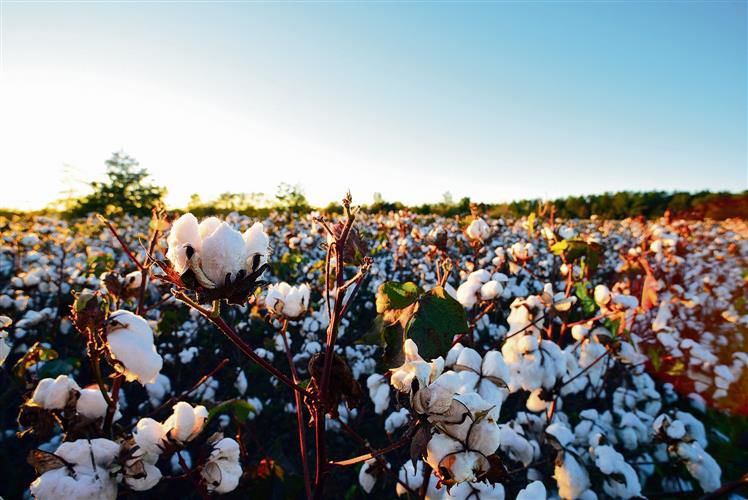Cotton: Take aggressive measures to bring back the glimmer of “white gold.”
India’s attempts to hold on to its top position, which it attained in 2002 with the introduction of transgenic Bt cotton hybrids, are being hampered by a decrease in cotton output. The Cotton Association of India produced a study in December of last year that states that the output of 294.1 lakh bales (each weighing 170 kg) in 2023–24 was around 8% less than that of the previous year and the lowest in the preceding 15 years. The difference between domestic output and the needs of the Indian textile sector is now 120 lakh bales.

Government data indicates that around 123.8 lakh hectares (ha) of cotton were seeded during the 2023 kharif season, a decrease of more than 3% from the previous year. A yield decline of almost 30% has happened over time; in 2013–14, it hit a maximum of 565 kg/ha. Three-quarters of the 330 lakh hectares of land in the world are farmed by cotton growers in India.
In the monsoon-dependent southern (Telangana, Andhra Pradesh, Karnataka, and Tamil Nadu) and central (Gujarat, Maharashtra, and Madhya Pradesh) zones, the area, output, and productivity varied between 2012–13 and 2021–22. Rajasthan increased its output from 17 to 25.97 lakh bales and its area from 4.5 to 7.07 lakh ha in the northern zone during this time, but its productivity fell (to 624 from 642 kg/ha). In spite of the 81,000 ha increase in area (from 6.14 to 6.95 lakh ha), productivity and output fell from 26 to 20.43 lakh bales and 720 to 500 kg/ha, respectively, in Haryana. Punjab’s acreage decreased to 3.04 from 4.8 lakh ha throughout these years, and output decreased to 13.65 from 21 lakh bales, while productivity rose by 21 kg per ha.
Punjab was only able to plant 2.4 lakh hectares of cotton in 2022–2023; this year, 2023–24, it dropped even lower to 1.75 lakh hectares. There was a 45% decline in yield over the previous year as a consequence of the state’s 45% failure to meet the government’s modest objective of 3 lakh acres.
A number of variables have lessened the luster of the “white gold,” which is occurring in the opposite direction as intended and is thought to be a suitable substitute for the high-water-requirement rice crop under the agricultural diversification plan. In rain-fed southern and central zones, adequate germination and plant establishment need intensive pre-sowing irrigation, which poses a challenge. A adequate amount of canal water is essential in the northern irrigated zone. Even with this guarantee, which was made in Punjab in April and May of last year, farmers’ faith was not regained, highlighting the significance of variables other than the availability of water when seeds are sown.
This year’s cotton seed market is expected to be worth $0.82 billion, of which 95% is controlled by private businesses that provide 95% of the region where transgenic hybrids are used. The industry for fake seeds has expanded across the states. In 2017, the South Asia Biotechnology Centre discovered that 8% of the 450 lakh cotton seed packages that were distributed in the states included erroneous information. Strict steps are required to combat the threat and provide farmers with real seeds. In order to stop this illicit activity, seed tracing may be greatly aided by the usage of the site and mobile app Sathi (Seed Tracing, Authentication, and Holistic Inventory).
Numerous bollworms, defoliators, and sap-sucking insects assault the crop. Due of their prolific reproduction, pests including mealybugs, miribugs, jassids, aphids, thrips, and whiteflies may grow to frightening proportions if left unchecked. In 2015–16, whiteflies decimated the crop. Scientists are faced with the challenge of finding new seeds that are resistant to pink bollworm (PBW), a lepidopteran pest that can cause 50–60% yield loss. This is because the Bt toxins in first and second-generation Bt cotton began to break down in response to PBW after about 2009 and 2014, respectively.
Approximately 45% of pesticides are used for controlling pests at different phases of crop development. According to studies, 27% of Punjab’s overall production costs are attributable to the use of pesticides in cotton.
Sadly, phony goods make pest control more difficult. The real pesticide market in India is developing at a pace of 12% each year, while the fake one is rising at a rate of 20%. Similar to phony seeds, bogus pesticides prove to be a double-edged sword when given out for free to unsuspecting farmers at crucial moments. They result in repetitive, pointless application, raising the expense of farming without yielding any benefits, and polluting the environment. Closing legal gaps, guaranteeing rigorous enforcement of the law, using the Sathi app to expedite traceability, fortifying the farm advisory system, raising farmers’ consciousness, reducing reliance on pesticides, and implementing IPM (integrated pest management) technology are all essential.
The available integrated pest management (IPM) modules generally involve avoiding overuse of nitrogenous fertilizers, fumigation and acid-delivered seeds, field sanitation, intercropping, crop rotation, removal of alternative and collateral hosts, planting barrier, border, and trap crops, uprooting and destroying infested plants, and regular monitoring.
ETL (economic threshold level) is checked before deciding on the need-based, prudent, and safe application of recommended pesticides. It is necessary to use the mating disruption method, eradicate pest-harbouring garbage from ginneries, and seed “refuge,” an isogenic non-Bt variant of Bt hybrids. Drones may be a great tool for practicing the “sterile insect release strategy,” which is why the US was designated a PBW-free nation in 2018. Simultaneously, increasing research efforts to bring accuracy in location-specific integrated pest management (IPM) modules under changing climate circumstances for coping with novel pest virulence efficiently may stop the decline in cotton agriculture.







